As an Amazon Associate I earn from qualifying purchases.
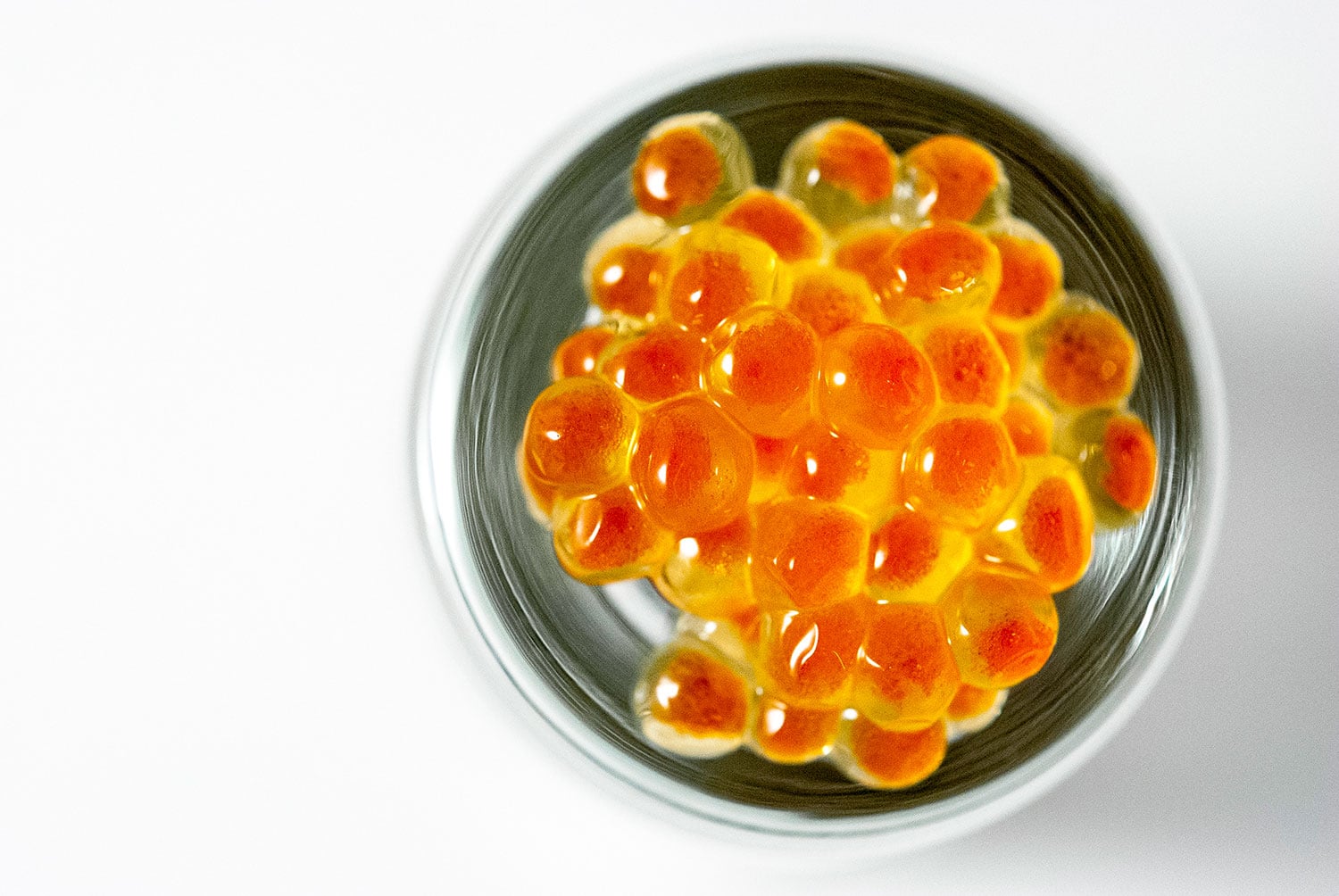
Caviar has always had a hold on me. It is a mysterious ingredient, almost otherworldy; the individual eggs look like jewels from an alien planet. Caviar tastes briny and vaguely floral, and the textural surprise of the pop in your mouth has led more than one writer to liken it to Pop Rocks for adults.
I’ve eaten all sorts of caviar, from spendy Osetra sturgeon caviar to our own California white sturgeon eggs, to Paddlefish roe to salmon roe ikura, to the wonderful little eggs from flying fish (tobiko), capelin and whitefish, which is a golden yellow. I’ve also eaten caviar from trout and char.
Steelhead roe is a particular favorite, as is king salmon roe.
I’d read about a general method of making caviar in a book called The Philosopher Fish, which involves gently removing the eggs from the skein — the membrane holding them together — rinsing them, salting them and drying them. It seemed pretty easy, which alarmed me: How could something so mysterious be so easy to create? It didn’t seem fair.
I delved into some more research, and it is indeed that easy. The art comes in the details: How do you get the eggs out of the skein? How much salt? How long to brine or rub the eggs? What temperature do you store them at?
So I use an amalgam of the methods I’d read about. I brine the salmon roe for a half hour in the fridge. Then I run the skein under hot tap water, which shrinks the membrane and lets the eggs drop into a colander. I then return the eggs to the brine for another 30 minutes. I rinse them off and let them drain in the colander for 15 minutes. Then I package them into a clean glass jar in the fridge. Done!
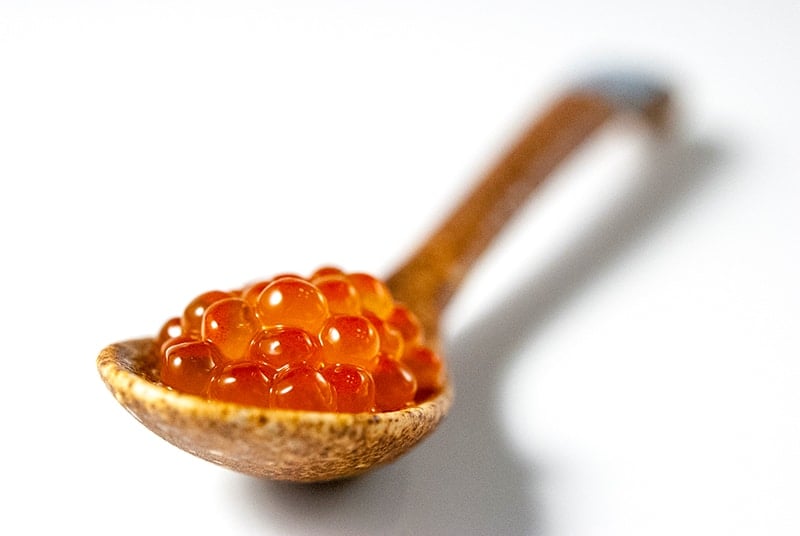
And there is an easier way: Run them over a cooling rack, membrane side up. Either method results in some egg loss, and the hot water trick can sometimes cook the eggs, which is no bueno.
Aren’t they the coolest things ever? I have a hard time not taking them out of the fridge just to look at them. homemade caviar keeps for 2 weeks in the fridge, but I think it gets fishy after about a week.
I prefer my caviar straight, served in a special spoon, so you can linger over the qualities of this caviar versus that one; this is what the Russians do when they serve the three classic sturgeon caviars: Beluga, Sevruga and Osetra. In case anyone cares, I am particularly fond of Osetra, which is pretty close to our caviar made from California white sturgeon.
Remove from your mind the notion that the only good caviar comes from sturgeon.
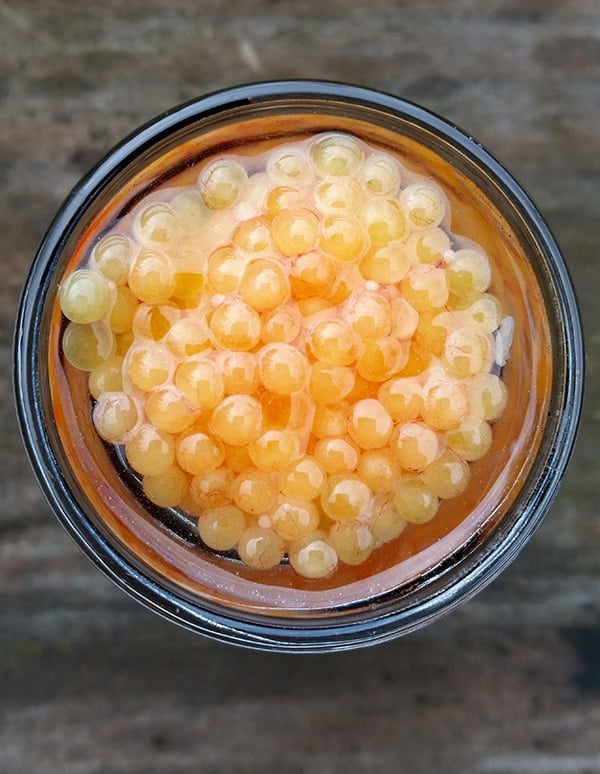
The tobiko and masago you see in sushi restaurants is caviar from the flying fish and the capelin, a kind of herring. It really is like pop rocks. Whitefish caviar is even better, and is a beautiful canary color. Lumpfish is like a larger sturgeon caviar, but trout and salmon caviar is its own thing: large, luxurious, and slightly fatty — I saw thousands of minute fat droplets floating on the top of the brine when I made it.
When combined with a larger dish, caviar can become an accent that makes a good dish great.
I make a pasta dish with flaked salmon, mixed with toasted pine nuts, parsley, shallots, olive oil, Meyer lemon juice — and a spoonful of salmon roe caviar. The color and pop really makes the dish.
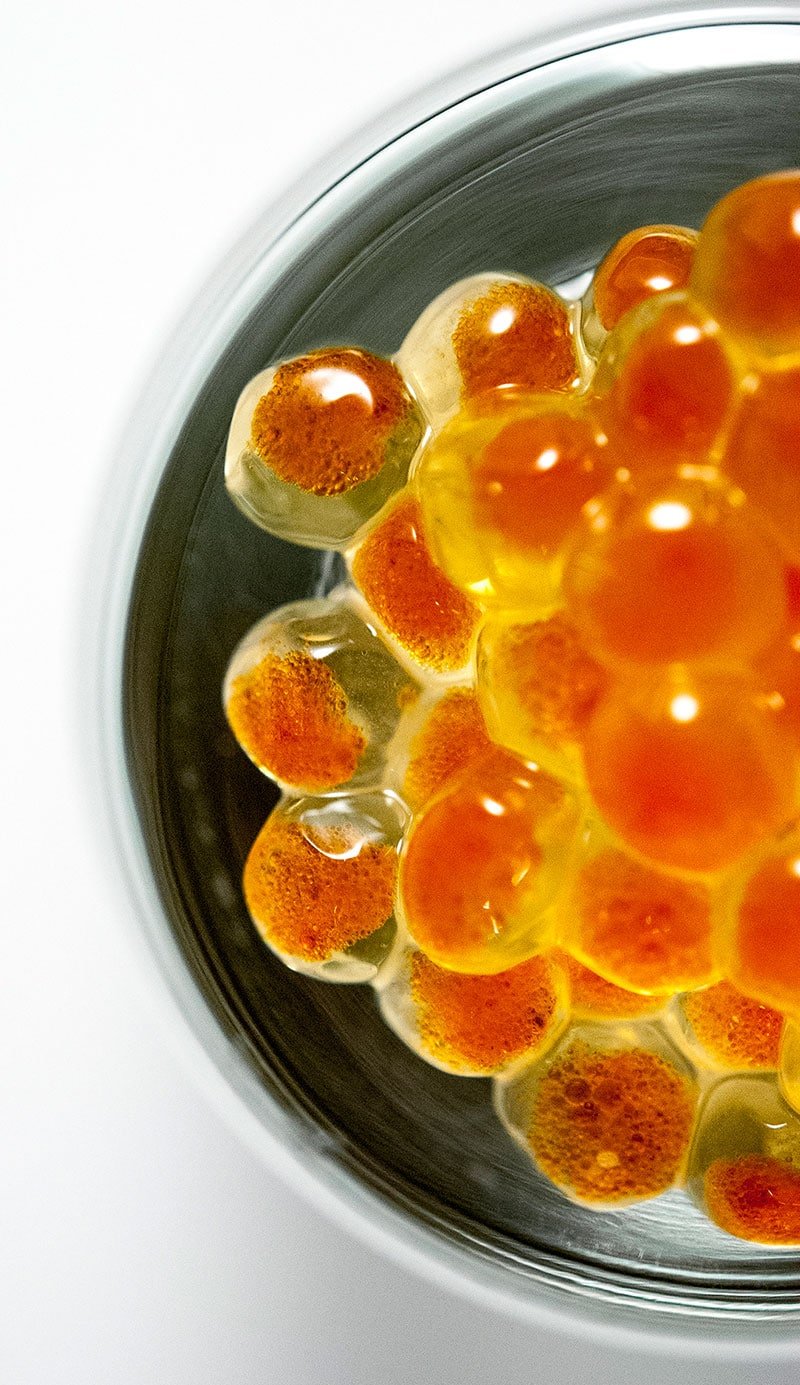
Homemade caviar also works well as a garnish for a simple Japanese dish of salmon or trout wrapped in buttered foil with some matsutake (or other) mushrooms, sake and lemon slices, then baked it for 20 minutes. Damn good.
Will this method work for other fish roes? Yep. I imagine the salting times and care you will need to dislodge the eggs will change, but the basic technique shouldn’t change.
How to Make Caviar
Ingredients
- 1 full skein of steelhead, trout or salmon roe
- 1/2 cup kosher salt
Instructions
- Mix the salt and 1 quart ice-cold water until the salt is all dissolved.
- Make sure the roe skeins are split, so you have an opening that the eggs can come out. Set up a cooling rack or something else with a wide mesh (chicken wire works, too) over a bowl. Take a roe skein and, with the membrane facing up work the eggs out through the rack. Perfectly ripe eggs will come off easily, unripe ones will require some force. Either way, you will pop some eggs in the process.
- ALTERNATE METHOD: Get the faucet running with warm water roughly 105°F to 115°F, or heat cool tap water to this temperature -- some people fear that hot tap water can add harsh minerals to their food. Either way works. Fill a metal or glass bowl with the warm water. Dunk a few skeins of roe at a time in the warm water. Gently massage the eggs out of the skeins with your fingers under the surface of the warm water. They will float away and sink. Discard the skeins.
- Have a fine-meshed sieve ready. Pour the strained eggs into the strainer to rinse them well with cold water. Pick out clumps or stray bits of membrane.
- Dunk the eggs in the brine for 5 minutes. Taste them and if they are salty enough for you, drain them again. You can brine for up to 30 minutes, but they will be very salty. My preferred brine time is 10 minutes. Spoon carefully into a clean glass jar and refrigerate for up to 2 weeks, but try to eat them within a week or they will start to get fishy.
Notes
Nutrition information is automatically calculated, so should only be used as an approximation.

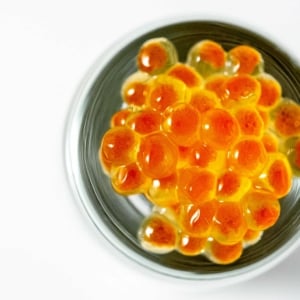
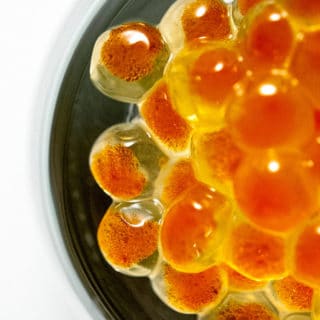
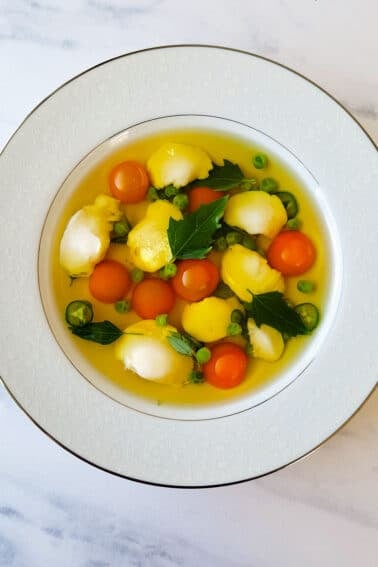
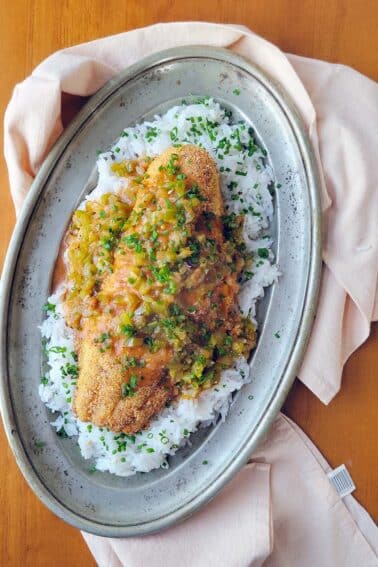
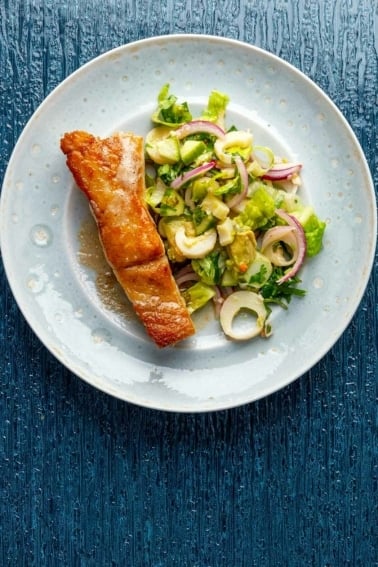
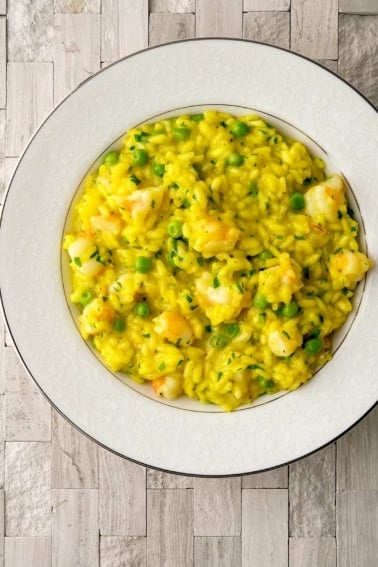
I am really looking forward to some early spring fishing on our local CO lakes after ice off. Last year was surprisingly productive. I was able to harvest some nice holdover stocked rainbows. I was surprised to find roe in one of the larger females during my cleaning. I was able to save some and prepared it similarly to your method. Yum!
This year I plan to be more deliberate with my harvest and preparation. Fun!
An excellent recipe, and simple to boot. I live in North Florida and use the red roe from our local mullet, which happen to make their annual run in December and January. 10 minutes of brine works fine for me, and tomorrow I’ll be putting mullet on the smoker to make fish dip. While I’m smoking them, I’ll smoke some salt to use for my brine. Reminds me of flying fish roe, an excellent garnish on sushi.
Hank,
Thanks again: I have used your caviar recipe before with Cutthroat roe. Excellent results.
I just made another batch which will be shared at a neighborhood Christmas party.
I really enjoy sharing such a unique dish as home prepared caviar.
Happy Holidays,
Karl
G’day mate. In the text above the recipe you say you brine for 30 min, then remove the eggs from the skein then brine another 30 min, then rinse.
In the recipe you only say to bring for 5-30 min once, and that you prefer to brine for 10 min only.
Which is it? 10 mins, or 60 mins?
Andrew: It’s closer to 10 minutes in a strong brine. Thanks for the catch. I need to update the headnotes.
Have you ever tried brining prawn or shrimp eggs? When I get our local spotted or side striped shrimp here they’ve always had tons of eggs on them, and very easy to strip off. I’ve had them raw before, and that’s fine, but I was wondering if there were any specific ways to brine them to convert to caviar, or if it’s the same as for fish roe?
hello,
thank you so much for the article. i’m not a fisherman. where’s the best place to acquire skein? I live in Oregon for what it’s worth. Should I go to a market? Find a fisherman? thanks for your help and time.
Erik: Find salmon fishermen and ask to have the eggs before they go out, to they can save them for you.
A pair of large hen walleye have left me with a couple pounds of roe. I noticed in a previous comment you mentioned about pike the risk of freshwater parasites. I happened to read that sentence with a mouth full of the brined, yet raw, walleye eggs. Is there a process that can reduce that risk while still keeping them raw? They’re quite tasty that way.
Keith: I have yet to hear of anyone getting a parasite from salted (brined) eggs, but it is theoretically possible. I err on the safe side when it comes to this sort of thing, at least when I am serving others.
Hello Hank,
I have a bunch of pike eggs in the freezer I was hoping to use up but research has left me confused on their edibility; some info online claims that they are toxic while many others say they enjoy them and I understand they are quite popular in Europe.
Do you know anything about them?
Have you ever eaten them raw?
Thanks!
Marc: Pike eggs are edible, sure. Some people get worried because yes, in theory, the salting process for making pike caviar – might – not be enough to kill all waterborne parasites. So there is some risk with using them in this recipe. But cooked they are certainly tasty.
I use this recipe every chance I get – at least once or twice a year for the last ten years, and sometimes much (much) more. Chinook eggs most of the time, this year mostly Coho. Always a winner, thanks Hank!
Are there risks of parasites or bacteria with this method? Specifically for rainbow, brown and brook trout caught in the Midwest. Already brined the roe and now I am concerned I should freeze them..
GrandSlam: Not that I know of, but that just means I haven’t found any studies covering this yet. I don’t generally freeze roe before making caviar, for what it’s worth.
While living in Northern Minnesota I took ready advantage of the states non- commercial whitefish netting program. During those years through the month of November all I ate for breakfast and lunch was caviar, like a hundred bucks a day worth. It got to the point I started wondering how it was affecting my cholesterol levels. Good cholesterol right?? RIGHT?!! I was aware that all recipes for preparing caviars involved brining but my attempts, because i didnt know what i was doing and whitefish eggs are soooo amazing, were never as good as unsalted. Just thoroughly cleaned and rested in the fridge overnight (why does the flavor improve so much with resting?).
Now however its Coho season in the Northwest and Ive got a pile of Eggs in the refrigerator waiting for me and after my initial run of the no salt version as before (They are pretty good) I am interested in trying the brining method again to compliment the much stronger flavor.
Thank you so much Hank Shaw for the website and recipes. I was very much feeling an outsider and freak , despite knowing i was in the right and the rest of my countrymen “just didn’t know”, for my constant proselytizing of all things Delicious. Your site has given me a renewed energy to keep up the good fight.
So easy, so good!
Hank~off topic but couldn’t think of another way to get an answer. I’m on day 9 with your bottarga process using shad roe. It’s been in the basement, salted daily changing towels. It’s pretty hard and won’t take anymore salt. It doesn’t smell fishy at all, more like the ocean. Should I move it to the fridge now or can I leave it sit out longer? Thanks!
I just made this last night with some steelhead roe from a fish I caught yesterday. It turned out great. I bought some salmon roe caviar from the store to compare my home made stuff to and I preferred the batch I made following this recipe.
I have made many of Hank Shaw’s recipes. As a hunter and angler I appreciate his creativity.
I’ve made this numerous times with all kinds of salmon and a few varieties of trout. The instructions are clear and the recipe is flexible. Hard to mess these up!
I like how you stated that when combined with a larger dish, caviar can become an accent that makes a good dish great. My husband absolutely loves Caviar, so I want to attempt to make it for our anniversary next month. I will definitely keep all of your great tips and information in mind when trying to make Caviar.
I just made a batch of caviar from red salmon Roe using your recipe. It is fantastic! I used a steel veggie steamer screen to push the eggs through. It was easy. Thanks for your method! I will be using it from now on.
Actually, Lumpfish is it’s own critter. It’s not Paddlefish. Paddlefish caviar makers are very proud of their products .. and call it that. Very close to the fine Russian caviars and easier to find (and cheaper). Whole Foods carries it. Lumpfish is actually a salt water fish and not a very pretty one. The eggs are real black when I have seen it. Though I don’t know if it is a natural color or not. For those folks that catch and bring home Paddlefish (Spoonbills), would this recipe work just as well or do you think changes should be made?
Sea Wolf: Interesting, I didn’t know that! And yes, I have actually used this very recipe for spoonbills.
I thought I had my salmon caviar recipe down pat — brine in one part salt and four parts water for 10-20 minutes depending on how salty you like it, wash off the brine in cold water and jar — but the last time I made a batch of coho caviar it turned out to be somewhat dry. The taste was OK but some of the eggs stuck together and seemed to be less oily than they should have been. Did i wash them too much or did I make some other mistake?
I thought I had my caviar recipe down pat: Chum best, then coho, chinook, steelhead, sockeye and pinks in that order; mix one part salt to 4 parts cold water, brine for 10-15 minutes depending on taste, wash off the brine in a colander and jar the caviar. But the last time I made some coho caviar the taste was fine but the eggs seemed too dry, a lot stuck together and there didn’t seem to be enough oil in the mix. Did I wash the eggs too much or what else did I do wrong?
Holger: Could just be the eggs themselves. I’ve had tacky eggs like that before.
Theon Greyjoy,
Yes, you can do this with almost any fresh water fish roe. Most of the commercial “caviar” has been frozen before canning anyhow. You just have to thaw it with care, and you will see very little difference.
The recipe for fresh water roe: empty the roe bag in to a bowl by making a small incision to one end of the egg sack, and push out the roe using the back of your knife or a spoon. Use a fork or a hand whisk to remove any veins and pieces of membrane by gently (I mean very gently) whisking the eggs.
Once the roe is clean, you must freeze the roe at least 24 hrs at least -18 C / 0 F.
Once this has taken care of all the nasties that might be in the fresh water fish eggs, you are ready to slowly de-freeze the roe in the fridge, and proceed with the salting or any other method you like. Thaw the roe in a mesh colander over a bowl, and you get nice loose eggs.